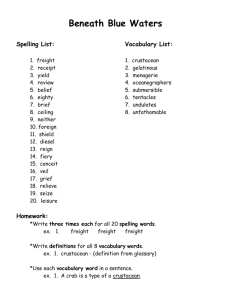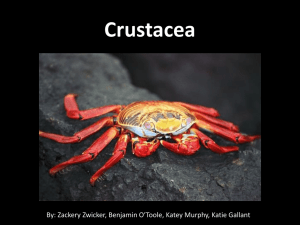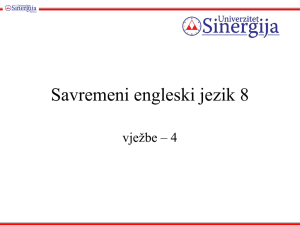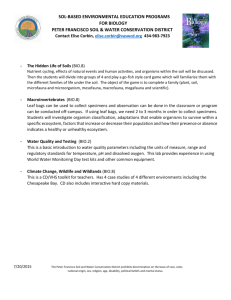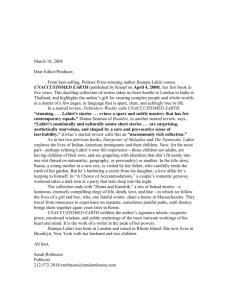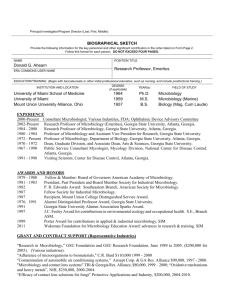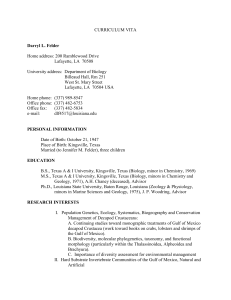How To Create Your Bio" step-by-step instructions
advertisement
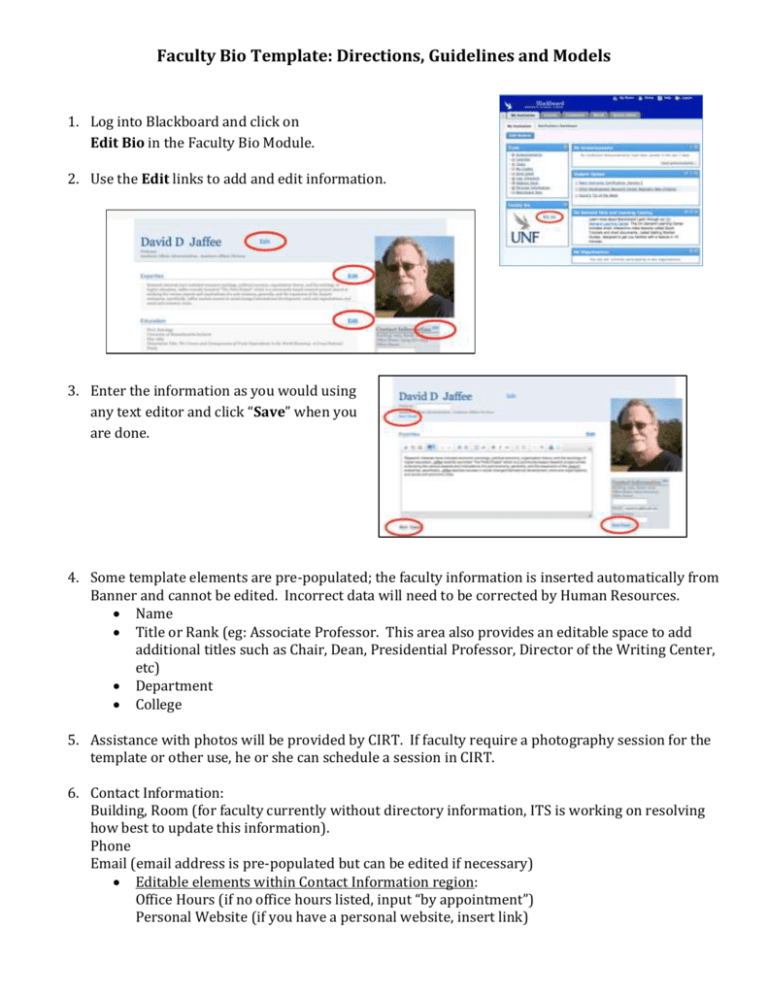
Faculty Bio Template: Directions, Guidelines and Models 1. Log into Blackboard and click on Edit Bio in the Faculty Bio Module. 2. Use the Edit links to add and edit information. 3. Enter the information as you would using any text editor and click “Save” when you are done. 4. Some template elements are pre-populated; the faculty information is inserted automatically from Banner and cannot be edited. Incorrect data will need to be corrected by Human Resources. Name Title or Rank (eg: Associate Professor. This area also provides an editable space to add additional titles such as Chair, Dean, Presidential Professor, Director of the Writing Center, etc) Department College 5. Assistance with photos will be provided by CIRT. If faculty require a photography session for the template or other use, he or she can schedule a session in CIRT. 6. Contact Information: Building, Room (for faculty currently without directory information, ITS is working on resolving how best to update this information). Phone Email (email address is pre-populated but can be edited if necessary) Editable elements within Contact Information region: Office Hours (if no office hours listed, input “by appointment”) Personal Website (if you have a personal website, insert link) 7. Areas of Expertise (Required) Identify single words or two-word phrases that capture your areas of expertise – words which best describe your areas of interest and align with your research and teaching. For example, you might enter words “whale”, “ocean”, “biology”, “oil spill”. We have already built the taxonomy that groups your keywords so that a user looking for an expert in “Environment” will pull your bio as well as other faculty who have keywords associated with Environment. See list of examples. Words and phrases should be separated by commas. 8. Education (Required) Suggested format is noted below: Degree, Area, Institution, Degree Date (month, year or just year). Most important is highest degree awarded and from what institution. EXAMPLE: Ph.D. Sociology University of Massachusetts-Amherst May 1984 M.A. Political Science Washington University-St. Louis August 1980 B.A. Political Science (Phi Beta Kappa) University of Florida December 1977 9. Biography (Required) This is a narrative area where you can expand on your current research or the areas of expertise that you identified above. This could be written in the first or third person. EXAMPLE: My laboratory is using electrophysiology, membrane vesicle techniques, cell culture, dissociated tissue cell suspensions, and molecular biology to investigate the physiology of molecular transport by epithelial cell membranes of fish and crustacean gastrointestinal and renal organs. Over the past 25 years we have used a variety of experimental techniques to investigate membrane transport processes in the crustacean gastrointestinal tract and antennal glands for nutrients, ions, and heavy metals. For the past 12 years, we have investigated the mechanisms of sugar, amino acid, and vitamin transport in the fish intestine as a scientific cooperative exchange program with the University of Lecce, Italy. Recently we have focused our work on investigating ion transport processes of crustacean epithelial cells and have discovered a novel 2Na+/1H+ transport protein in crustacean cell membranes which significantly differs physiologically from its mammalian counterpart. We are currently investigating this interesting invertebrate protein with molecular biology techniques which will allow us to identify the gene that codes for the protein and compare it to the DNA sequences responsible for analogous proteins in vertebrates. In addition, we have recently shown that this transporter is involved in heavy metal uptake from the environment and are currently investigating the interaction of this carrier system with epithelial detoxification processes for a variety of heavy metals. EXAMPLE: UAlbany Distinguished Professor of Economics Kajal Lahiri is an expert on economic forecasting, applied econometrics, as well as regional and national economic trends. In 2004, Lahiri developed the Transportation Services Index, currently utilized by the U.S. Department of Transportation to track and measure the U.S. Economy. Over the past two decades, Lahiri's development of statistical methods to study economics and related subjects has had wide-ranging policy applications. 10. Awards (Optional) EXAMPLE: Recipient of The John A. Delaney Endowed Presidential Professorship (2008-2011) International Fulbright Scholar - Hong Kong Fulbright Scholar, US Department of State. 2009-2010 Outstanding Researcher, Coggin College of Business, UNF. 2003, 2005, 2006 Outstanding Teacher, Coggin College of Business, UNF. 2005 Distinguished Professor, 2007 11. Affiliations (Optional) 12. Grants and Contracts Awarded (Optional) It is suggested that faculty go back no more than 5 years in the list of awards. Format should be Grant Agency, Title of Grant, Award Amount, Year of Award EXAMPLE: US Department of Agriculture: Synergistic Absorption of Essential Amino Acids and Metals by Shrimp Digestive Tract - $350,000 (2010) National Science Foundation: RUI: Heavy Metal Detoxification in Crustaceans - $144,907 (2004) AASCU: Taking it to the Streets: Investigating Social Problems and Improving Student Outcomes through Community Based Research - $5,000 (2007) 13. Publications & Presentations (Optional) It is suggested that faculty go back no more than 4 years in the list of publications and presentations. List chronologically, beginning with most recent. EXAMPLE: Obi, I., Wells, A.L., Ortega, P., Patel, D., Farah, L., Zanotto, F. P. and Ahearn, G. A. (2011) 3H-L-leucine transport by the promiscuous crustacean dipeptide-like cotransporter. J. Exp.Zool. (in press). Obi, I. E., Sterling, K. M., and Ahearn, G. A. (2011) Transepithelial D-glucose and D-fructose transport across the American lobster, Homarus americanus, intestine. J. Exp. Biol. 214: 2337-2344. William R. Harvey, Bernard A. Okech, Paul J. Linser, David A. Price, James J. Becnel,Gregory A. Ahearn, and Kenneth M. Sterling. (2010) H+ V-ATPase-energized transporters in brush border membrane vesicles from whole larvae of Aedes aegypti. J. Insect Physiol. 56:1377-1389.. Sterling, K. M. and Ahearn, G. A. (2011) Glucose and fructose uptake by Limulus polyphemus hepatopancreatic brush border and baso-lateral membrane vesicles - Evidence for Na+-dependent sugar transport activity. J. Comp. Physiol. B. .181: 467-475. Ahearn, G. A. (2010) Heavy metal transport and detoxification in crustacean gastrointestinal and renal epithelial cells, IN: J. Koropatnick and R. K. Zalups, eds, Cellular and Molecular Biology of Metals, Taylor and Francis, CRC Press, pp.295-326. 14. You can view your bio at the following link: http://www.unf.edu/bio/
